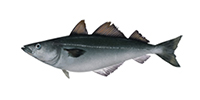Thank you for visiting the Seafood Selector. EDF is planning a new approach to providing information to consumers about good seafood choices. Please come back soon for updates.
Pollock

Pollock
Recommended servings per month
| Contaminant | Men | Women | Kids 6-12 | Kids 0-5 | |
|---|---|---|---|---|---|
| Imitation crab (non-Alaska) | Mercury | 4+ | 4+ | 4+ | 4+ |
| Alaska pollock (U.S.) | Mercury | 4+ | 4+ | 4+ | 4+ |
| Atlantic pollock (U.S.) | Mercury | 4+ | 4+ | 4+ | 4+ |
| Atlantic pollock (Canada trawl) | Mercury | 4+ | 4+ | 4+ | 4+ |
| Atlantic pollock (Canada longline, gillnet) | Mercury | 4+ | 4+ | 4+ | 4+ |
| Atlantic pollock (Norway, Faroe Islands, UK, Greenland, Germany, Denmark) | Mercury | 4+ | 4+ | 4+ | 4+ |
Eco details:
- Pollock, a relative of cod, is the main component of fish sticks, fish filet sandwiches and imitation crab (surimi).
- These fish mature quickly and have high rates of reproduction, allowing them to better withstand fishing pressure.
- Alaska pollock is the largest fishery in the U.S., and populations are healthy. They are caught with midwater trawls, which result in very low rates of bycatch.
- Atlantic pollock is not nearly as abundant as its Pacific cousin, and it is most often caught by bottom trawl or gillnet. In New England, pollock are now caught under an innovative new ‘sector’ management plan. Discards in the fishery have dramatically decreased, sector fishermen stayed under their catch limits for all groundfish species, and less gear was deployed compared to previous years.




